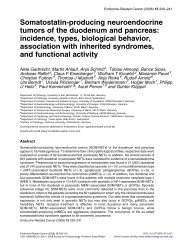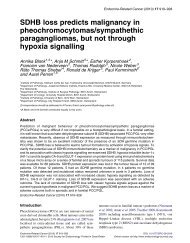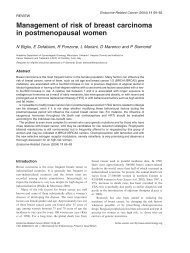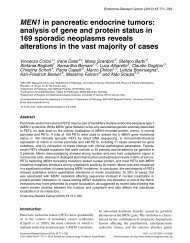Aromatase and gynecomastia - Endocrine-Related Cancer
Aromatase and gynecomastia - Endocrine-Related Cancer
Aromatase and gynecomastia - Endocrine-Related Cancer
You also want an ePaper? Increase the reach of your titles
YUMPU automatically turns print PDFs into web optimized ePapers that Google loves.
Braunstein: <strong>Aromatase</strong> <strong>and</strong> <strong>gynecomastia</strong><br />
with severe <strong>gynecomastia</strong> was treated with 450 mg/day<br />
Δ 1 -testolactone for 6 months with ‘moderate regression of<br />
the gynaecomastia’. However, after 6 months he escaped<br />
from the effects of the drug both clinically <strong>and</strong><br />
biochemically. During the first three months on Δ 1 -<br />
testolactone, the serum levels of testosterone increased<br />
twofold, the <strong>and</strong>rostenedione levels by tenfold, <strong>and</strong><br />
estradiol was decreased by 50% without a change in<br />
estrone levels, but the levels returned to baseline by 6<br />
months. Stratakis et al. (1998) treated a brother <strong>and</strong> sister,<br />
aged 10 <strong>and</strong> 7½ years respectively, who suffered from the<br />
excessive peripheral aromatase syndrome, with a<br />
combination of gonadotropin releasing hormone analog<br />
<strong>and</strong> Δ 1 -testolactone (40 mg/kg/day orally). The<br />
combination decreased pubertal progression, skeletal age,<br />
estrone <strong>and</strong> estradiol levels, but the authors did not<br />
comment on the effects on breast development, other than<br />
to state that the boy was treated with bilateral reductive<br />
mammoplasties.<br />
Zachmann <strong>and</strong> colleagues (1986) treated 22 boys with<br />
pubertal <strong>gynecomastia</strong> with 450 mg Δ 1 -testolactone by<br />
mouth daily for two to six months without side effects.<br />
Before therapy, the mean breast diameter was 4.4 cm<br />
(median=3.8, n=22). After 2 months of therapy, the mean<br />
diameter had decreased to 3.3 cm (median=3.0, n=22),<br />
after 4 months to a mean of 3.2 cm (median=2.8, n=14),<br />
<strong>and</strong> after 6 months to a mean of 1.7 cm (median=1.5,<br />
n=4). They noted that several weeks before the reduction<br />
in the breast size there was a softening of the gl<strong>and</strong>ular<br />
tissue. During therapy, pubic hair <strong>and</strong> testicular volume<br />
increased normally. While on therapy, there were<br />
significant increases in serum testosterone (to a maximum<br />
of 1.5 times baseline), <strong>and</strong>rostenedione (13.5 times<br />
baseline), dehydroepi<strong>and</strong>rosterone (1.2 times baseline),<br />
estrone (1.6 times baseline) <strong>and</strong> follicle-stimulating<br />
hormone (1.3 times baseline), but no significant change in<br />
estradiol, luteinizing hormone, or prolactin concentrations.<br />
These authors did not note how many of their<br />
patients had complete disappearance of the <strong>gynecomastia</strong><br />
or how many were satisfied with the results.<br />
In an unpublished, prospective study of 4 patients with<br />
idiopathic <strong>gynecomastia</strong> of long st<strong>and</strong>ing duration, we<br />
gave escalating doses of Δ 1 -testolactone at doses of<br />
150 mg for 2 months, then 300 mg for 2 months, <strong>and</strong><br />
finally 750 mg for 2 months. On this regimen, the mean<br />
breast size decreased 28% at 2 months, 32% at 4 months,<br />
<strong>and</strong> 47% at 6 months (P






